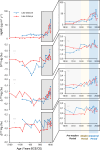Mercury Isotope Variability in Pyrenean Lake Sediments during the Late Holocene: Sources, Deposition, and Environmental Controls
- PMID: 40556935
- PMCID: PMC12186775
- DOI: 10.1021/acsearthspacechem.4c00402
Mercury Isotope Variability in Pyrenean Lake Sediments during the Late Holocene: Sources, Deposition, and Environmental Controls
Abstract
Atmospheric mercury (Hg) emissions represent a persistent global threat to ecosystems and human health. Stable Hg isotopes have emerged as powerful tools to trace historical pollution sources and reconstruct depositional pathways in natural archives. In this study, we present a 4000-year reconstruction of Hg isotopic composition from two Pyrenean lake sediment records (Lake Marboré and Lake Estanya) located along an altitudinal gradient and compare them with those of a nearby ombrotrophic peatland (Estibere mire). Both lakes exhibit a long-term increase in Hg accumulation rates and shifts in isotope values since the onset of the Modern Period (∼16th century), consistent with intensified anthropogenic emissions. However, the isotopic patterns differ: Lake Estanya, located in a lowland area with historical land-use changes, reflects a more localized Hg signal, whereas the high-elevation, remote Lake Marboré preserves a broader regional atmospheric imprint, dominated by wet deposition. The comparison with Estibere mirepristine and situated within the same air mass trajectory as Marboréreveals a consistent offset in Δ199Hg values yet strikingly similar temporal trends, indicating a shared regional source signal modulated by ecosystem-specific processes. This multiarchive and multialtitude framework provides a rare opportunity to disentangle Hg source signatures from depositional and postdepositional transformations. Moreover, variations in even-MIF (Δ200Hg) in the alpine lake show the potential to reflect past climate phases, highlighting the additional value of Hg isotopes as paleoclimatic proxies. Our results underscore the importance of integrating different ecosystem archives to improve reconstructions of atmospheric Hg dynamics and to refine interpretations of legacy pollution and climate interactions.
Keywords: Pyrenees; isotopes; lake sediments; legacy pollution; mercury.
© 2025 The Authors. Published by American Chemical Society.
Figures





Similar articles
-
Watershed runoff as a dominant pathway for mercury loading into a karst lake as unraveled by a novel mercury isotope and flux balance model.Water Res. 2025 Sep 1;283:123820. doi: 10.1016/j.watres.2025.123820. Epub 2025 May 13. Water Res. 2025. PMID: 40382875
-
Sediment magnetic record of anthropogenic environmental changes in the catchment of a typical submerged macrophyte-dominated lake over the last approximately 168 years.J Environ Manage. 2025 Sep;391:126438. doi: 10.1016/j.jenvman.2025.126438. Epub 2025 Jul 2. J Environ Manage. 2025. PMID: 40602242
-
Application of mercury stable isotopes to examine sources and hydrologic factors impacting mercury bioaccumulation and cycling in invertebrates of a model saline lake.Water Res. 2025 Sep 15;284:123946. doi: 10.1016/j.watres.2025.123946. Epub 2025 Jun 4. Water Res. 2025. PMID: 40499201
-
Isotope tracking of anthropogenic Cu and Zn in urbanized coastal environments: A review.Mar Pollut Bull. 2025 Jul 2;220:118337. doi: 10.1016/j.marpolbul.2025.118337. Online ahead of print. Mar Pollut Bull. 2025. PMID: 40609422 Review.
-
Direct composite resin fillings versus amalgam fillings for permanent posterior teeth.Cochrane Database Syst Rev. 2021 Aug 13;8(8):CD005620. doi: 10.1002/14651858.CD005620.pub3. Cochrane Database Syst Rev. 2021. PMID: 34387873 Free PMC article.
References
-
- Anual Z. F.. et al. Mercury and risk assessment from consumption of crustaceans, cephalopods and fish from West Peninsular Malaysia. Microchemical journal. 2018;140:214–221. doi: 10.1016/j.microc.2018.04.024. - DOI
-
- UNEP Global Mercury Assessment 2013: Sources, Emissions, Releases and Environmental Transport; UNEP Chemicals Branch: Geneva, Switzerland, 2013.
LinkOut - more resources
Full Text Sources
Miscellaneous
